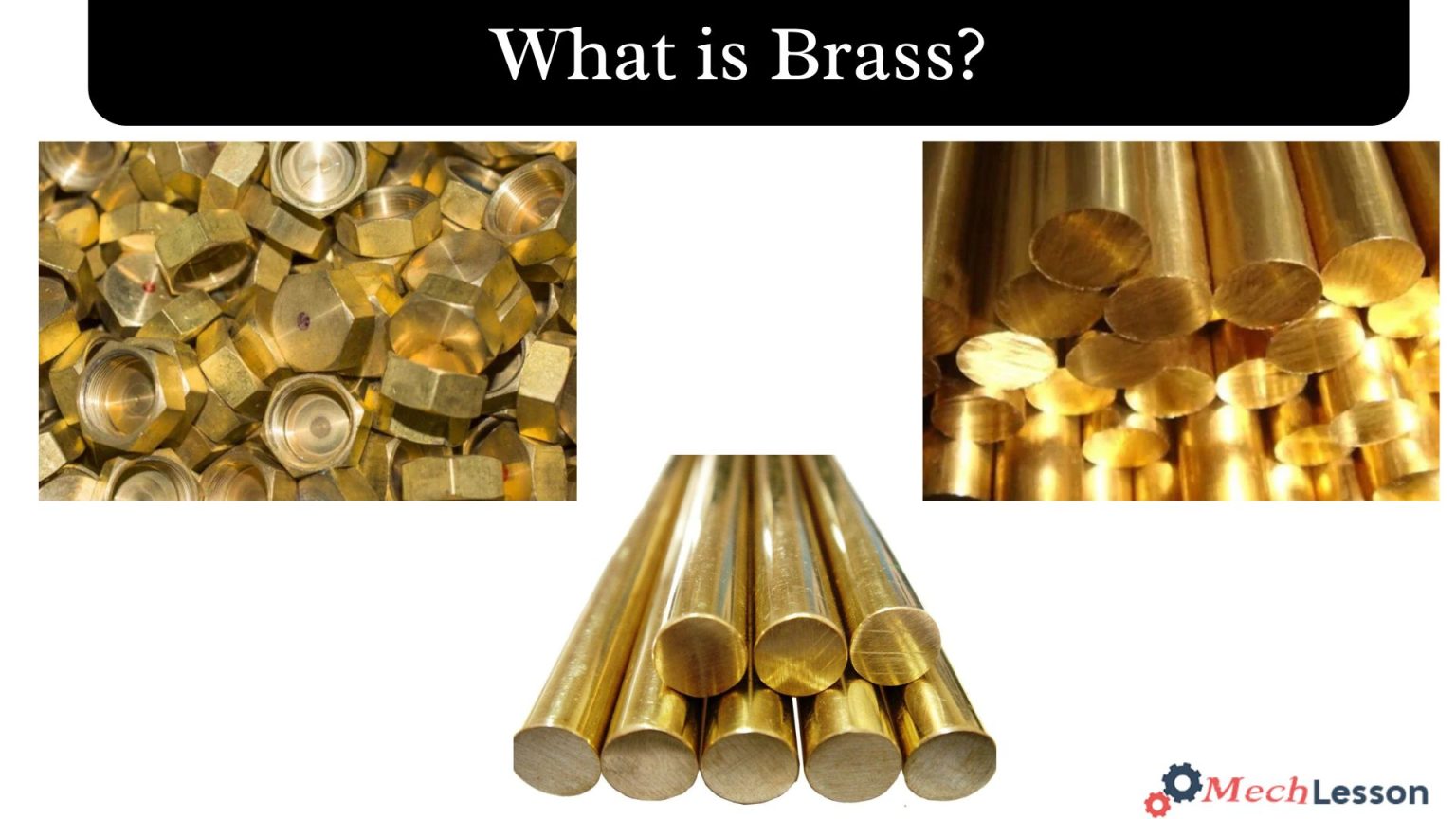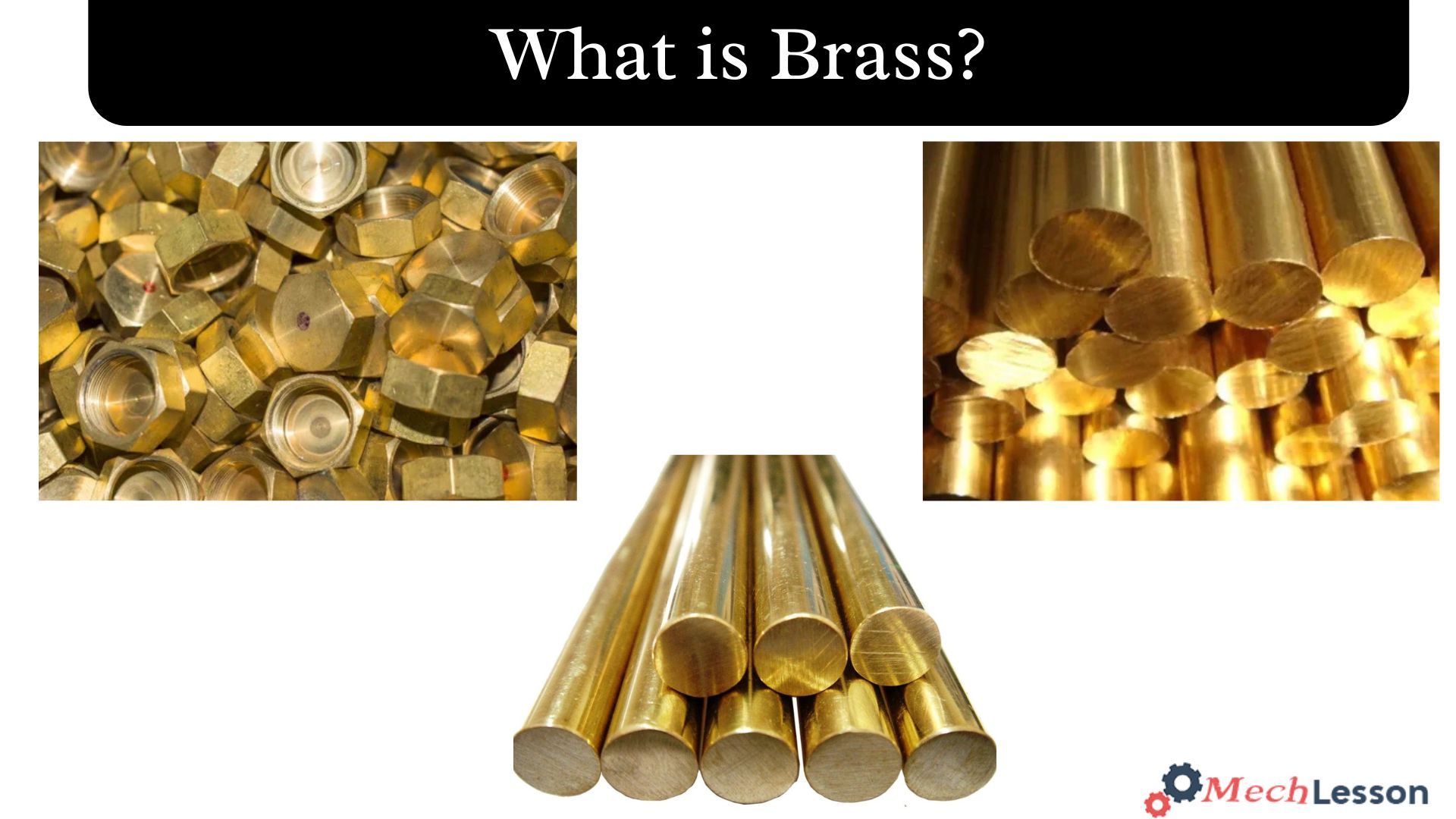Brass is an easy-to-machine metal alloy that is resistant to germs and saltwater. Although copper and zinc make up the majority of this metal, it also contains trace quantities of lead, iron, and other metals.
With a nearly $22 billion gross export value in 2023, the United States ranked as the world’s fourth-largest exporter of brass. Chile ($40 billion) was the greatest, followed by Japan ($24.7 billion) and Germany ($29 billion).
In this reading, we’ll explore what brass is, its diagram, properties, types and their uses.
Let’s begin!
Read about copper with this detailed guide!
What is Brass?
Brass is an alloy of copper and zinc, in proportions that can be varied to achieve different colours and mechanical, electrical, acoustic and chemical properties, but copper typically has the larger proportion, generally 2⁄3 copper and 1⁄3 zinc.
This substitutional alloy, which has been in use since the ancient era, allows the atoms of the two ingredients to swap places inside the same crystal structure. Bronze, a copper alloy with tin instead of zinc, is comparable to brass.
Small amounts of a variety of additional elements, such as silicon, manganese, lead, phosphorus, aluminium, and arsenic, can be found in both brass and bronze. Museums are increasingly using the more broad term “copper alloy,” since historically the distinction between the two alloys has been less obvious and consistent.
Diagram
Types of Brass
Three different types of brass are as follows:
Read about Bronze with this detailed guide!
1. Alpha Brasses:
The homogeneous (alpha) crystal structure of alpha brasses, which are created when less than 37% of zinc is fused into copper, gives them their name. An alpha crystal structure is created when zinc dissolves in copper, producing a solid solution with a uniform composition.
These brasses can be cold worked, welded, rolled, pulled, bent, or brazed more easily than their counterparts because they are softer and more pliable. The most common type of alpha brass is composed of 70% copper and 30% zinc. Often referred to as 70/30 brass or “cartridge brass,” this brass alloy offers the best strength and flexibility for cold drawing.
Because it contains more zinc than brass, it also resists corrosion better. Alpha alloys are used to make fasteners like wood screws and spring contacts in electrical sockets.
2. Alpha-Beta Brasses:
Alpha-beta brasses, often referred to as “duplex brasses” or “hot-working brasses,” are composed of both alpha and beta grain structures and have a zinc concentration of 37–45%. Atomically, beta-phase brass is more similar to pure zinc.
The proportion of alpha-phase to beta-phase brass is determined by the zinc concentration. However, the amount of beta-phase brass in the alloy may also be increased by alloy constituents like silicon, tin, or aluminium.
Despite being more prevalent than alpha brass, alpha-beta brass is stronger, tougher, and less ductile under cold conditions. Alpha-beta brass is less costly due to its higher zinc concentration, but it is more vulnerable to dezincification corrosion.
Alpha brasses are substantially more workable at high temperatures than alpha-beta brasses, which are less workable at room temperature. Even when lead is added to improve machinability, these brass do not break easily.
The most popular hot-working techniques for alpha-beta brass are thus die-casting, stamping, and extrusion.
3. Beta Brasses:
The third kind of brass alloy that has more than 45% zinc is called beta brass. Compared to alpha or alpha-beta brasses, they are far less prevalent. These brasses are stronger and more resilient than alpha and alpha-beta brasses because they contain a beta crystal structure.
Read about Malleability with this detailed guide!
Because of this, they can only be cast or hot wrought. We can examine the impact of alloying metals on brass by classifying brass alloys based on their properties rather than their crystal structure.
Free-machining brass, high-tensile brass, navy brass, dezincification-resistant brass, cold-working brass, and casting brass are examples of common beta brasses. Yellow brass is derived from a brass alloy with a higher zinc content (33 percent zinc), whereas red brass is a high copper (85 percent) alloy that incorporates tin (Cu-Zn-Sn).
Properties of Brass
Brass’s properties are determined by how much copper and zinc it contains. To enhance the quality of brass, other metals, including tin, aluminium, lead, and nickel, are commonly added. Some of brass’s characteristics are as follows:
- Usually brilliant gold, brass may also be silvery-white or reddish gold. More zinc gives the alloy a silvery look, while more copper gives it a rose tone.
- The melting point of brass is low, ranging from 9000 to 9400 degrees Celsius.
- Because of its non-magnetic properties, brass is a popular metal for electrical and electronic equipment. Separating it from scrap is easy.
- Because of its inherent antibacterial properties, brass does not harbour infections, such as bacteria or other microorganisms. It is thus advised for doorknobs and faucets.
- Brass may be pliable. When stretched or pulled into little wires, it does not shatter. Tensile pull occurs when metal is drawn into wires.
- Compared to copper and zinc, it is more elastic.
- Because of its high copper content, brass is anti-corrosive and is shielded from corrosion by a protective coating.
- Brass is perfect for musical instruments because of its acoustic qualities.
- The brass metal’s surface resists deterioration. Additionally, it resists friction well.
- Heat and electricity can flow through brass since metal is an excellent conductor of both. The strands of brass in electric wires carry electricity.
Uses of Brass
- Durable and corrosion-resistant architectural alloy used in architectural trims, hedges, and historical structure restoration.
- Low friction in metal-on-metal contact makes brass ideal for mechanical components like gears, locomotive axle boxes, and marine engines.
- Highly coveted hand tools due to their longevity.
- Common component in plumbing and electrical systems, including electrical sockets, switches, valves, and pipe fittings.
- Traditional musical instrument maker, producing trumpets, french horns, trombones, and tubas.
- Interior components used in electric instruments like electric guitars and violins.
Read about Zinc with this detailed guide!
FAQs
What is brass used for?
Brass is still commonly used in applications where corrosion resistance and low friction are required, such as locks, hinges, gears, bearings, ammunition casings, zippers, plumbing, hose couplings, valves, SCUBA regulators, and electrical plugs and sockets.
Is brass real gold?
While gold and brass have a distinctive yellow metallic lustre, they’re very different in terms of their chemical, physical, and application characteristics. Gold is a pure metal; brass, however, is an alloy or combination of copper and zinc.
Can brass jewellery rust?
Yes, brass jewellery tarnishes, but no it does not rust.
The reason for the tarnish is that brass is an alloy of copper and zinc, which will naturally tarnish when exposed to oxygen. Oils from your skin in addition to oxygen in the air accelerate tarnishing on your brass jewellery.
Does brass gold fade?
While it looks shiny when you first buy it, brass has a tendency to tarnish pretty quickly, especially once the gold plating wears off. Once exposed, brass reacts with your skin’s oils and moisture, often leaving you with a greenish tint on your skin.


